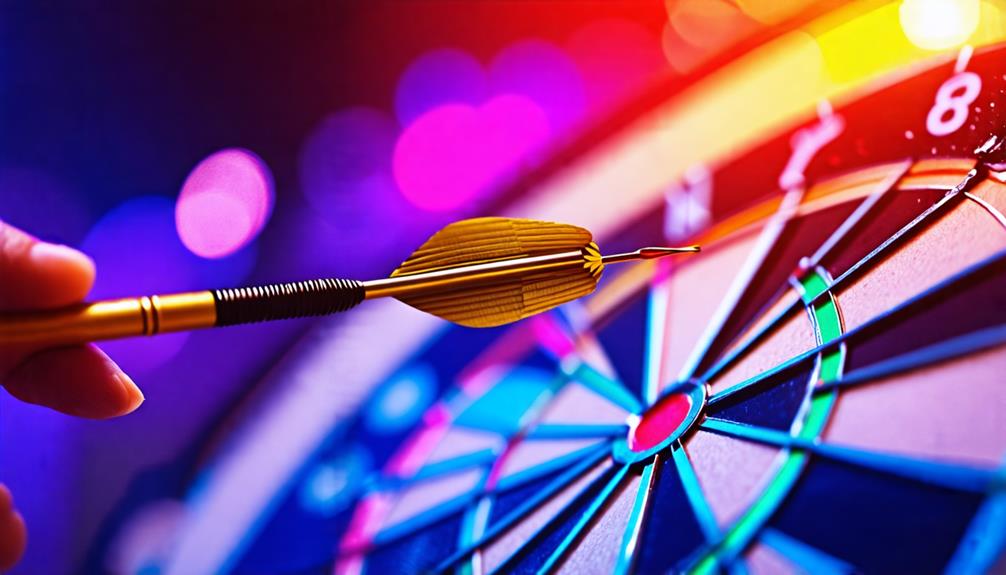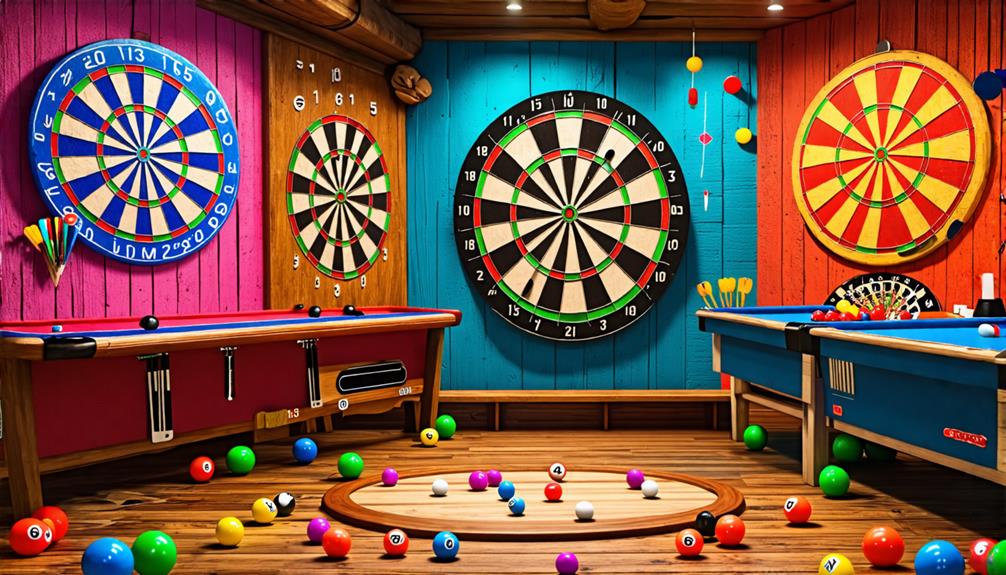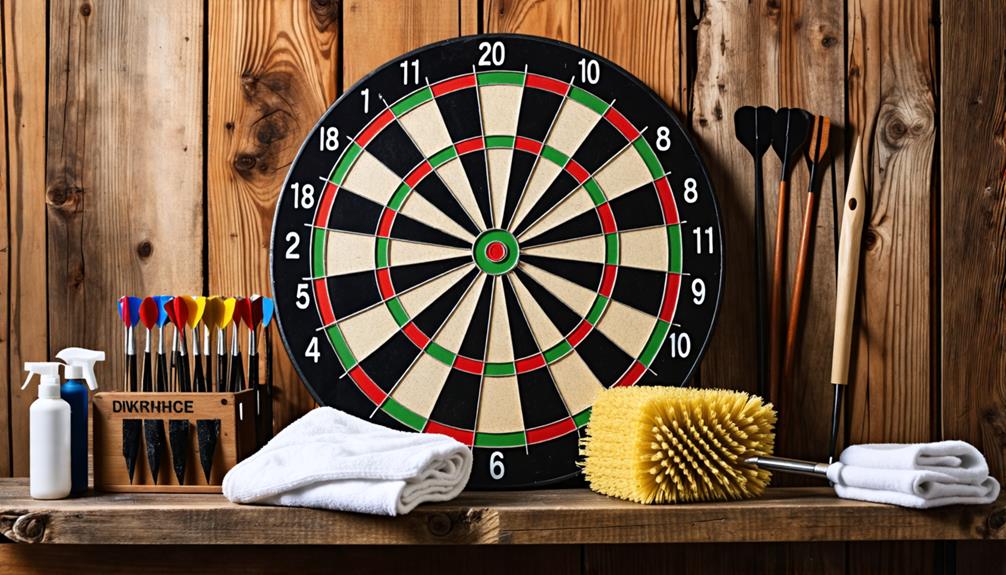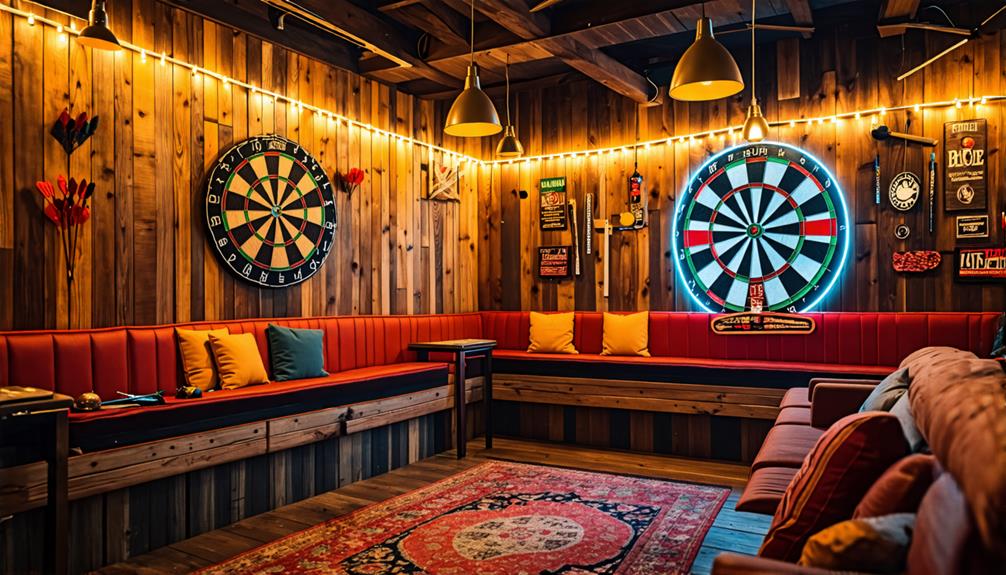How to Choose the Best Dartboard for Your Game Room
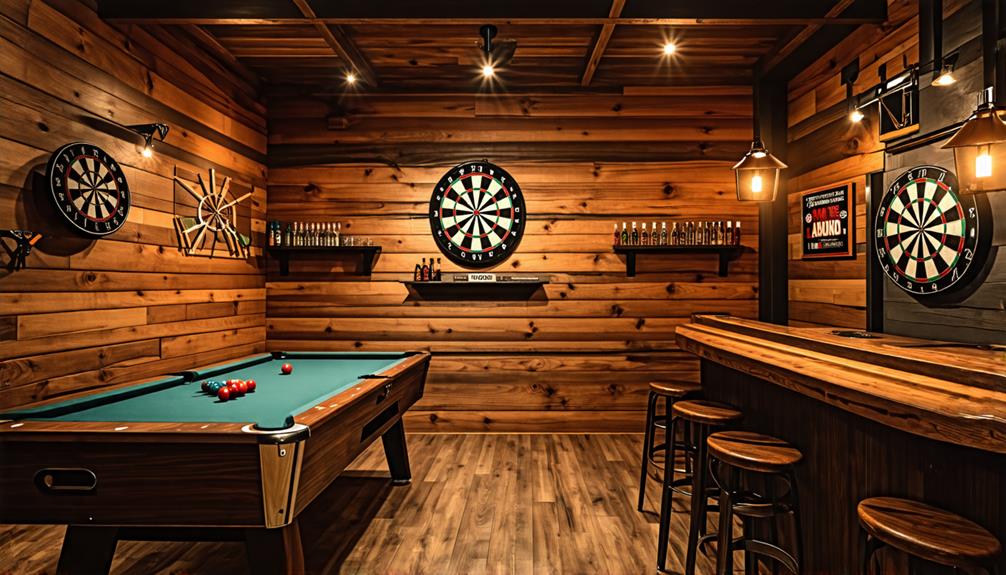
Choosing the best dartboard for your game room involves considering your personal preferences and specific needs. Whether you opt for a traditional bristle board or a modern electronic one, each option offers unique benefits. Factors like material quality, wiring design, and available space are crucial to making an informed decision. Though these considerations might seem daunting, they are essential for enhancing your gameplay experience. So, what should you prioritize when selecting a dartboard? Let's explore the key features that can make a significant difference.
Understanding Dartboard Types
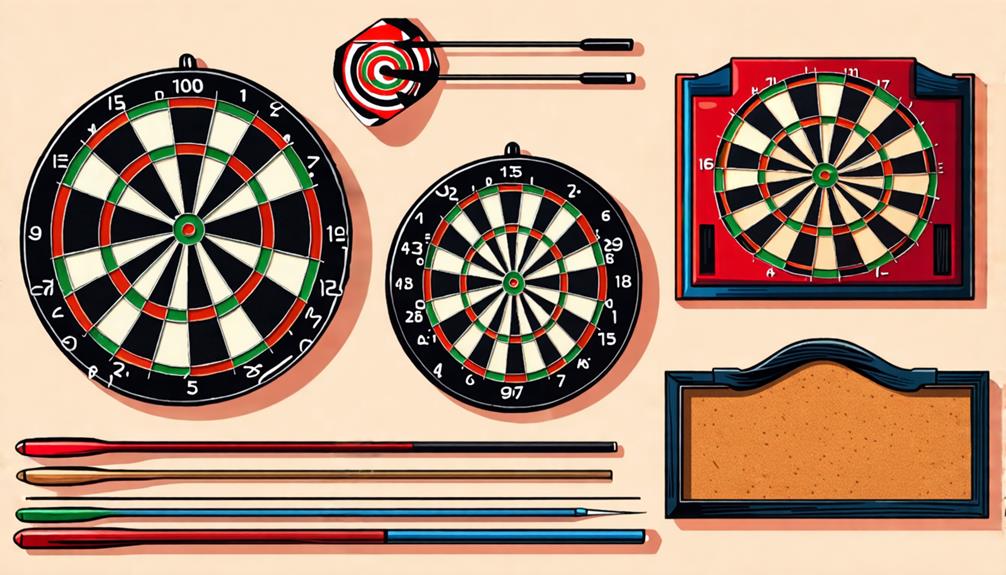
When choosing a dartboard, understanding the different types available is crucial, as each is designed to suit various playing styles and environments. Bristle dartboards, made from durable sisal fibers, offer longevity and self-healing properties that minimize wear, making them ideal for serious players and competitive settings.
Conversely, electronic dartboards use soft-tip darts and feature automatic scoring systems, making them user-friendly and perfect for beginners and casual players who prefer multiple game modes and the ease of automated scoring. For those prioritizing safety, especially in family settings, magnetic dartboards are a great option. These dartboards use magnets instead of sharp tips, providing a fun and risk-free experience for both children and adults.
When choosing a dartboard, consider the benefits of each type: bristle boards offer a traditional feel and durability, while electronic boards provide convenience and interactive features. Understanding these differences will help you select the dartboard that best fits your playing style and environment.
Key Features to Consider
When selecting a dartboard, it's important to consider the quality of materials, the wiring configuration, and the type of scoring system. High-quality sisal boards are durable and have self-healing properties. Wiring affects how well darts stick to the board, and choosing between manual and electronic scoring systems can significantly influence your playing experience. Evaluate these factors carefully to make an informed decision.
Material Quality Importance
Material quality is crucial for the durability and performance of your dartboard, directly impacting your overall gameplay experience. Choosing a bristle dartboard made from high-quality sisal fibers is essential. These fibers have self-healing properties, allowing the board to recover from dart impacts, which enhances longevity and reduces wear and tear. Durability is another key factor. High fiber density in sisal boards minimizes bounce-outs, ensuring darts stay embedded and improving your scoring potential. Frequent bounce-outs can frustrate players and diminish enjoyment.
While electronic dartboards offer the convenience of automatic scoring, they're usually made from plastic and generally lack the durability of traditional bristle boards. Investing in reputable brands like Winmau or Unicorn can provide additional assurance of performance and resilience, often backed by warranties for added peace of mind.
Wiring Configuration Types
Choosing the right wiring configuration for your dartboard can significantly enhance your gameplay experience and scoring potential. Dartboards generally feature three main wiring types: staple-free, round wire, and triangular wire. Each configuration influences bounce rates and dart retention.
For serious players, a staple-free wiring configuration is often the best choice. Its low profile reduces the chances of darts bouncing out and enhances durability. If you're aiming to minimize bounce-backs, opt for triangular wire boards. These are specifically designed to reduce bounce-backs, allowing darts to stick better and remain in the board.
Players generally prefer thin wires over thicker ones because they provide a larger target area, improving gameplay and reducing scoring interruptions. For professional standards, consider dartboards with thin, angled wiring configurations. These are crucial for competitive play, as they maintain the integrity of the game and enhance scoring potential. Ultimately, selecting the appropriate wiring configuration can significantly elevate your dart-playing experience, making it more enjoyable and rewarding.
Scoring Systems Variations
Choosing the right scoring system can significantly impact your dart-playing experience. Both electronic and manual systems have distinct advantages, so consider your preferences and skill level when selecting a dartboard.
Comparison of Scoring Systems:
| Feature | Electronic Boards | Bristle Dartboards |
|---|---|---|
| Scoring Method | Automatic Scoring | Manual Calculations |
| Game Modes | Multiple Options Available | Traditional Games |
| Interaction | Voice Prompts & Sound Effects | Hands-On Interaction |
| Ideal For | Casual Players | Experienced Players |
| Maintenance | Low (requires batteries) | Moderate (requires upkeep) |
Electronic dartboards offer automatic scoring, an array of game modes, and interactive features like voice prompts and sound effects, making them ideal for casual players who enjoy a relaxed atmosphere. They are low maintenance but do require batteries. Bristle dartboards, on the other hand, involve manual scoring, which appeals to experienced players who appreciate the strategic aspect of the game. Manual scoring can deepen your understanding and enhance your competitive experience. Ultimately, if you favor ease and social play, an electronic dartboard is a great choice. For those who seek a more traditional and skill-intensive game, a bristle dartboard is recommended. Choose based on what best fits your playing style!
Evaluating Size and Space
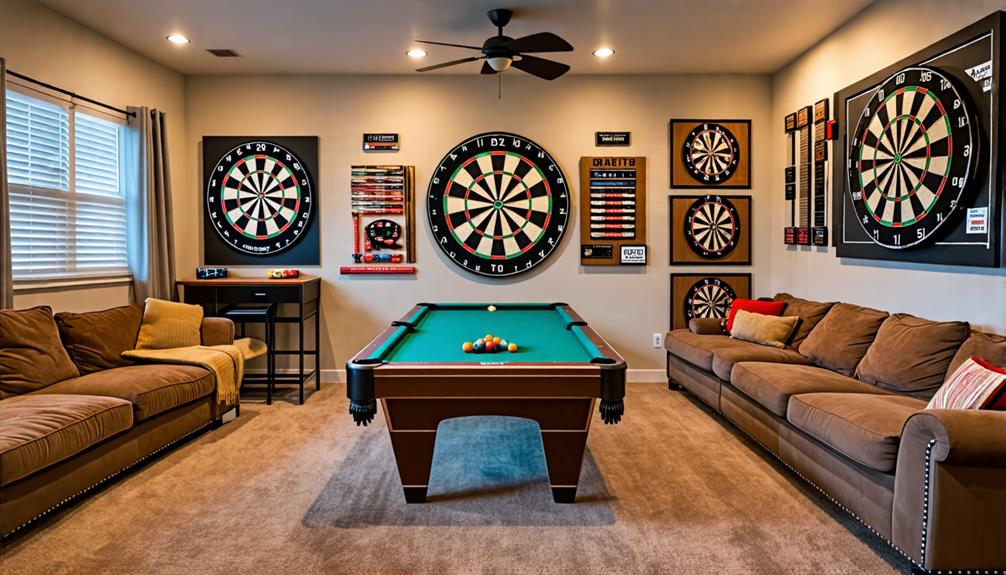
When planning your dartboard setup, ensure you have enough space to throw darts comfortably and safely. The size of your game room is crucial for the successful installation of your dartboard. Here are some key considerations:
- Wall Space: Standard dartboards are 18 inches in diameter. Ensure you have unobstructed wall space for a clear throw.
- Clearance: Maintain at least 5 feet of space in front of the dartboard for safe throwing.
- Height: Mount the dartboard so that the bullseye is 5 feet 8 inches from the floor, in line with official standards.
- Room Dimensions: Account for the overall dimensions of your game room, including additional furniture or seating, while maintaining a safe throwing area.
If space is limited, consider a cabinet-style dartboard, which can store darts and reduce visual clutter when not in use. Taking these aspects into account will help create a safe and enjoyable dart-playing environment.
Material Durability and Quality
Material durability and quality are pivotal for an enjoyable and long-lasting dart-playing experience. When selecting a dartboard, consider bristle boards made from sisal fibers. These fibers are renowned for their durability and self-healing properties, enabling the board to endure repeated impacts without significant wear. High-quality sisal boards often feature higher fiber density, reducing bounce-outs and enhancing overall performance.
While bristle boards are preferred by serious players, electronic dartboards offer a different experience. Made from plastic, they include features such as automatic scoring and various game modes. However, electronic boards typically require more maintenance than traditional bristle boards.
Investing in a quality board from reputable brands like Winmau or Target can provide peace of mind, as these brands often offer warranties that reflect confidence in their products' longevity and material quality. Choosing the right material ensures you'll enjoy your dart games for years to come, so take the time to assess your options carefully.
Importance of Wiring Design
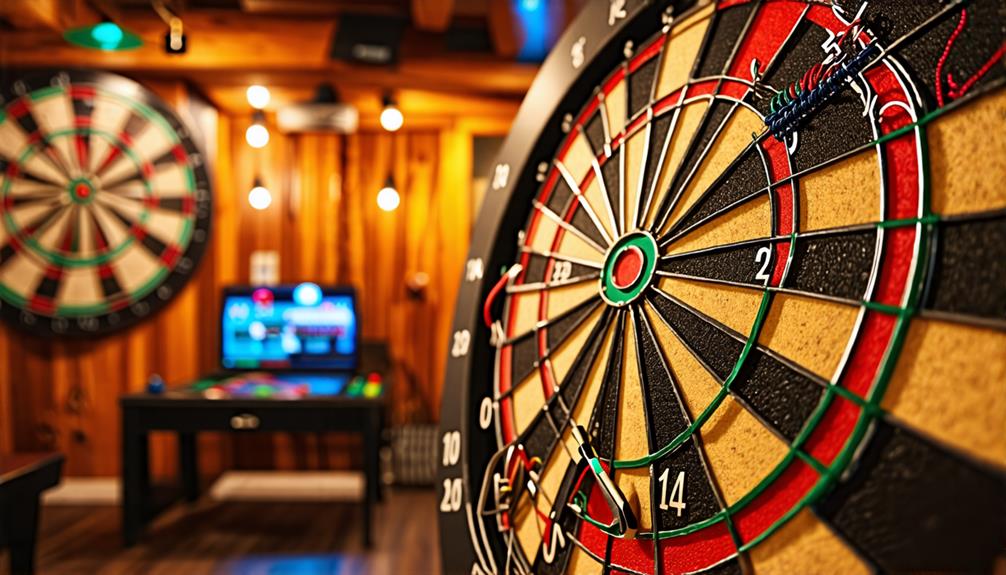
Wiring design is essential for optimal dartboard performance, significantly impacting dart retention and minimizing bounce-outs. When selecting a dartboard, keep the following wiring design features in mind:
- Thinner Wiring: Opt for dartboards with ultra-thin knife-edge wiring. This reduces the surface area and enhances dart retention, leading to fewer bounce-outs.
- Triangular Wiring Configurations: Many professional dartboards use triangular wiring. This design effectively directs darts into the board, improving your overall playing experience.
- Angled Wiring: Dartboards with angled wiring help darts penetrate the board more effectively, further reducing bounce-outs.
- High-Quality Construction: Invest in high-quality dartboards that feature superior wiring designs and robust construction. These boards not only withstand frequent use but also promote self-healing in bristle boards, extending their lifespan.
Assessing Player Skill Levels
When evaluating your skill level in darts, it's essential to choose a dartboard that aligns with your experience. Beginners might opt for lightweight bristle boards or magnetic options designed for kids. Advanced players should consider professional-grade boards to challenge and enhance their skills.
Beginner-Friendly Options
Considering your skill level, you'll want to explore dartboards tailored for beginners to ensure an enjoyable experience.
Here are several beginner-friendly options that can enhance your dart game and boost your confidence:
- Bristle Boards: Lightweight and perfect for new players, these boards use steel-tipped darts. They offer a traditional experience that helps in skill development.
- Magnetic Dart Boards: Ideal for young players, these boards use magnetic darts, promoting safe play without sharp tips. They're excellent for family settings and casual games.
- Electronic Dart Boards: These boards come with automatic scoring and various game modes, reducing intimidation and enhancing enjoyment. They're perfect for beginners.
- Paper Dart Boards: A budget-friendly option, paper dartboards allow you to practice without substantial financial investment while still providing fun gameplay.
Advanced Player Preferences
Advanced players often prioritize high-quality bristle dartboards made from durable sisal fibers, ensuring they can withstand intensive practice sessions. These boards are designed for longevity and self-healing, making them ideal for serious competitors. Additionally, the wiring configuration is crucial; boards with ultra-thin, angled wiring significantly reduce bounce-outs, allowing for better dart retention and comprehensive gameplay.
Here's a quick reference table highlighting advanced player preferences:
| Feature | Importance |
|---|---|
| Bristle Dartboards | Durability and self-healing |
| Sisal Fibers | Enhances longevity |
| Regulation Size | 18 inches diameter for professional play |
| Moveable Number Rings | Extends board lifespan |
Many advanced players also enjoy electronic dartboards with sophisticated scoring systems and multiple game modes, adding complexity to their practice sessions. By considering these factors, you can choose a dartboard that aligns with your advanced gameplay needs and provides an optimal experience in your game room.
Safety for Children
Choosing the right dartboard for children involves prioritizing safety while encouraging their enjoyment and skill development. Consider the following options to ensure a fun and secure environment:
- Magnetic Dartboards: These eliminate the risk of injury from sharp-tipped darts, making them ideal for casual play.
- Velcro Dartboards: These provide durability and safety for younger players, allowing them to practice without the danger of pointed darts.
- Lightweight Dartboards: Select dartboards that are easy to handle and mount, ensuring that kids can engage with the game comfortably.
- Adult Supervision: Ensure adult supervision when beginners use bristle dartboards with steel-tipped darts to maintain a safe playing environment.
Installation and Mounting Options
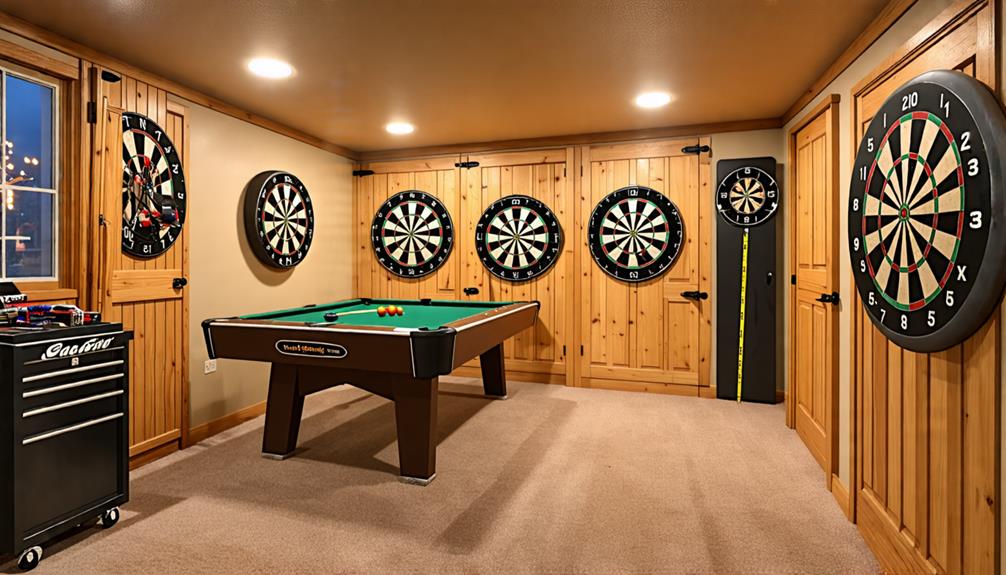
To ensure an enjoyable and safe gameplay experience, mount your dartboard at the standard height of 5 feet 8 inches from the floor to the center of the bullseye. For a secure installation, use a sturdy wall-mounted bracket or a dartboard cabinet with built-in mounting systems. This setup will prevent any wobbling during play, ensuring accuracy with each throw.
Consider the space around your dartboard as well. Maintain a minimum distance of 7 feet 9.25 inches from the front of the dartboard to the throwing line (oche). This complies with official regulations and provides players with enough room to throw comfortably without any obstructions.
Additionally, think about using a dartboard surround. This accessory not only protects your walls from stray darts but also enhances the aesthetic appeal of your game room. Ensure the mounting location has adequate space around it so players can move freely without bumping into furniture or other obstacles.
Budgeting for Your Dartboard
When budgeting for a dartboard, it's essential to consider both the initial purchase price and the ongoing costs of accessories that enhance your gaming experience. Dartboards can range from under $40 for budget models to over $200 for premium options. Here's a detailed breakdown of what to consider:
- Initial Cost: Determine your budget for the dartboard itself. High-quality boards like bristle or electronic types are often more durable and a better long-term investment.
- Accessory Costs: Include the cost of essential accessories such as darts, flights, and protective surrounds, which can add an additional $30 to $100.
- Seasonal Sales: Look for discounts during holidays or special events to save money on your purchase.
- Customer Reviews: Research customer reviews to ensure you're getting good value, particularly if you're considering budget-friendly options.
Maintenance and Care Tips
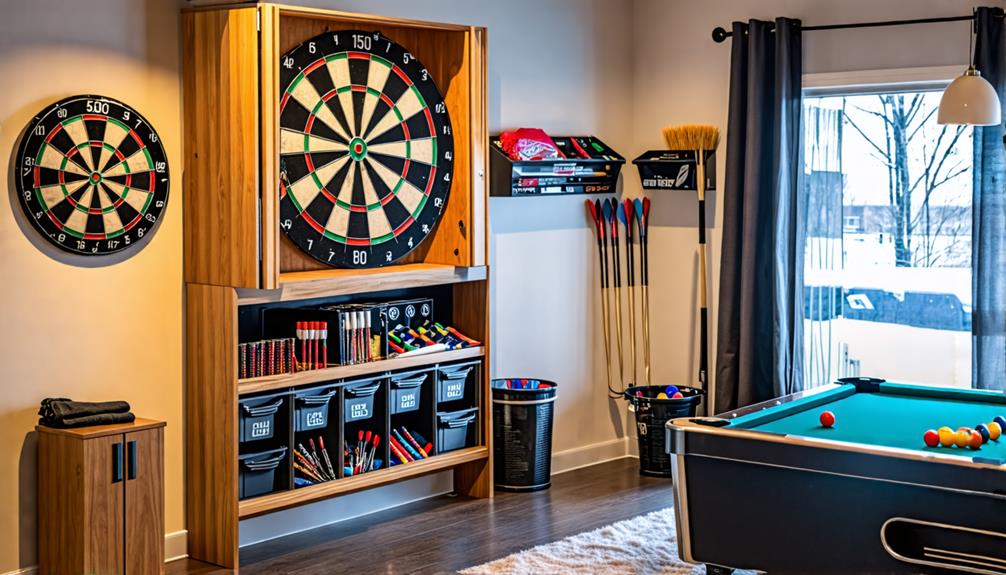
To maintain your dartboard's optimal condition, rotate it every few weeks to ensure even wear. Clean the surface regularly using a soft brush or cloth, and store the board in a dry place to prevent moisture damage. Following these tips will enhance your dartboard's performance and longevity.
Regular Rotation Practices
Regularly rotating your dartboard every few weeks helps distribute wear evenly, extending its lifespan and ensuring optimal playability. By rotating your board, you'll minimize the impact of repeated dart throws, preserving its self-healing properties and maintaining its top condition for longer.
Here are some simple tips for effective rotation practices:
- Rotate Every 90 Degrees: Turn your dartboard a quarter turn to allow different sections to bear the impact, preventing deep holes and uneven wear.
- Mark the Position: Use a piece of tape or a marker to note the current top position, helping you remember where to rotate next.
- Create a Schedule: Set reminders on your phone or calendar to rotate the board regularly, ensuring consistent maintenance.
- Combine with Cleaning: Pair your rotation practices with a gentle cleaning routine using a soft brush to keep your dartboard in peak condition.
Cleaning and Moisture Control
Maintaining your dartboard's cleanliness and dryness is crucial for optimal performance and durability. Regular cleaning preserves its playability and appearance. Use a soft brush to gently remove chalk dust, dirt, and debris. This simple action prevents buildup that can negatively impact your game.
Moisture control is also essential. Excessive moisture can damage the sisal fibers, compromising the board's self-healing properties. Ensure your dartboard is kept in a dry environment, away from direct sunlight and heat sources, as these conditions can warp the board and degrade its structural integrity over time.
Periodically inspect your dartboard for signs of wear and tear. Address any issues promptly to prevent further deterioration. Additionally, rotating the dartboard every few weeks ensures even wear across the surface, extending its lifespan and maintaining consistent play quality.
Enhancing Your Game Room Decor
Enhancing your game room decor begins with selecting a dartboard that aligns with your personal style and complements the overall theme of the space. Whether you lean towards a vintage bristle board or a sleek modern electronic board, the design should harmonize with your existing decor.
To elevate your game room, consider these tips:
- Choose a dartboard with vibrant colors and graphics: This creates a visually engaging focal point that enhances the room's atmosphere.
- Incorporate dartboard surrounds or backboards: These protect your walls and add to the visual appeal, ensuring a cohesive look.
- Opt for a decorative cabinet: A stylish cabinet can house the dartboard and add an elegant touch to your decor.
- Accessorize with matching darts and storage solutions: Coordinated accessories tie the decor together, making your game room feel complete and inviting.
Conclusion
Selecting the ideal dartboard for your game room can significantly enhance your playing experience. Consider the type of dartboard, material quality, and installation space to find the perfect match for your needs. Additionally, take into account your budget and maintenance requirements to ensure durability. The right choice won't only provide endless entertainment but also elevate your game room's decor, making it a welcoming environment for friends and family. Enjoy your darting!
